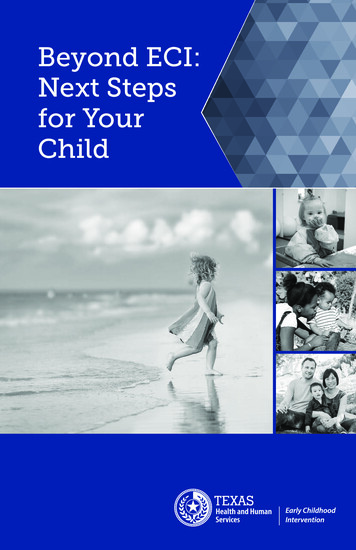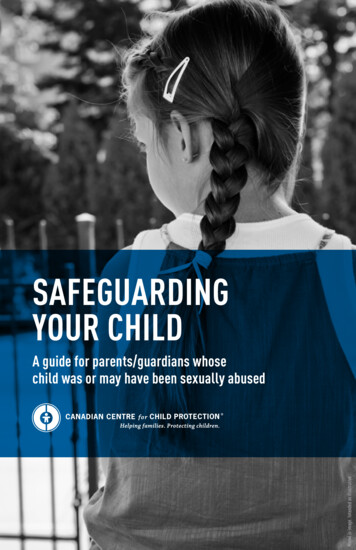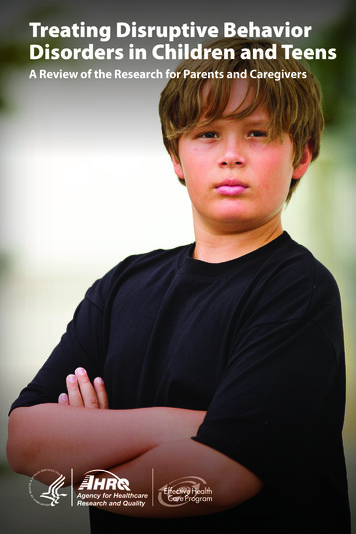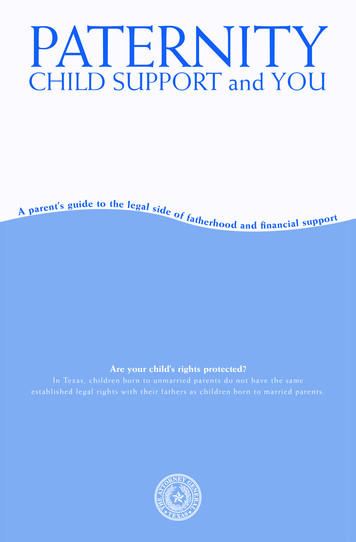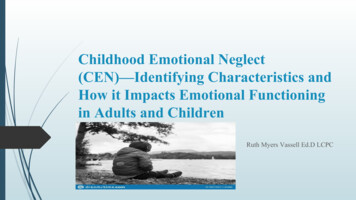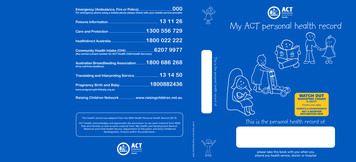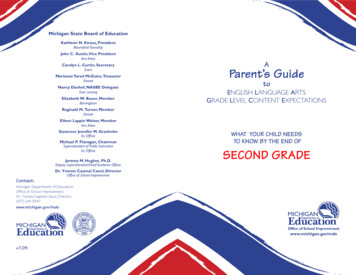
Transcription
Michigan State Board of EducationKathleen N. Straus, PresidentBloomfield TownshipJohn C. Austin,Vice PresidentAnn ArborAediuG tneraPCarolyn L. Curtin, SecretaryEvartotMarianne Yared McGuire,TreasurerDetroitSNOITATCEPXE TNETNOC LEVEL EDARGNancy Danhof, NASBE DelegateEast LansingSDEEElizabethN DLIHCUOY TMemberAHWW.RBauer,AFO DNE EHT BirminghamYB WONK OTeReginalddiuGM. tTurner,nerMemberaPHTAM/NETRoAt GR E D N I KDetroitEileen Lappin Weiser, VEL EDARGGovernor Jennifer M. GranholmEx OfficioSDMichaelEEN DP.LIFlanagan,HC RUOYTAHWChairmanSuperintendent of Public InstructionFO DNE EHTExYOfficioB WONK OTH TA M / N E TR A GR E D N I KJeremy M. Hughes, Ph.D.Deputy Superintendent/Chief Academic Officer.PLYvonneEH NACaamalC UOYCanul,WOHDirector&Dr.Office of School ImprovementAA GuideParentParent’s toGuideGRADE LEVEL CONTENTEXPECTATIONStoENGLISH LANGUAGE ARTSWHAT YOUR CHILD NEEDSGRADE LEVELTOCONTENTEXPECTATIONSKNOW ABY THE END OFParent GuideKINDERGARTEN/MATHto& HOWYOU CANHELP.GRADE LEVELCONTENTEXPECTATIONSWHAT YOUR CHILD NEEDSYOURCHILDENDNEEDSTOWHATKNOWBY THEOFTO KNOW BY THE END OFSECOND GRADEKINDERGARTEN/MATH& HOW YOU CAN HELP.Contact:Michigan Department of EducationOffice of School ImprovementDr. Yvonne Caamal Canul, Director(517) 241-3147www.michigan.gov/mdeOffice of School Improvementwww.michigan.gov/mdev.7.05
A Parent Guide to Grade LevelContent ExpectationsA Parent Guide to Grade LevelContent ExpectationsMichigan Sets High Academic Standards –for ALLMichigan Sets High Academic Standards –for ALLThis booklet is a part of Michigan’s Mathematics and EnglishLanguage Arts Grade Level Content Expectations (GLCE). It isjust one in a series of tools available for schools and families.The Michigan Department of Education (MDE) provides similarbooklets for families of children in kindergarten through eighthgrade.This booklet is a part of Michigan’s Mathematics and EnglishLanguage Arts Grade Level Content Expectations (GLCE). It isjust one in a series of tools available for schools and families.The Michigan Department of Education (MDE) provides similarbooklets for families of children in kindergarten through eighthgrade.Teacher versions of the Grade Level Content Expectations arefinished for grades Kindergarten through eight. They state inclear and measurable terms what students in each grade areexpected to know and be able to do. They also guide thedesign of the state’s grade level MEAP tests required in the NoChild Left Behind Act (NCLB) legislation.Teacher versions of the Grade Level Content Expectations arefinished for grades Kindergarten through eight. They state inclear and measurable terms what students in each grade areexpected to know and be able to do. They also guide thedesign of the state’s grade level MEAP tests required in the NoChild Left Behind Act (NCLB) legislation.Educators and classroom teachers from Michigan schooldistricts have been involved in the development and/or reviewof Michigan’s GLCE. The expectations were designed toensure that students receive seamless instruction, from onegrade to the next, leaving no gaps in any child’s education.More importantly, they set high expectations in literacy andmathematics so we can better prepare all K-12 students forthe challenges they will face in a global 21st century.Educators and classroom teachers from Michigan schooldistricts have been involved in the development and/or reviewof Michigan’s GLCE. The expectations were designed toensure that students receive seamless instruction, from onegrade to the next, leaving no gaps in any child’s education.More importantly, they set high expectations in literacy andmathematics so we can better prepare all K-12 students forthe challenges they will face in a global 21st century.To learn more about the Michigan Curriculum Framework, visitwww.michigan.gov/mde and click on “K-12 Curriculum.”To learn more about the Michigan Curriculum Framework, visitwww.michigan.gov/mde and click on “K-12 Curriculum.”Michigan Department of EducationGLCE Parent Guide - 2nd Grade ELAMichigan Department of EducationGLCE Parent Guide - 2nd Grade ELA
Second Grade English Language Arts (ELA)Second Grade English Language Arts (ELA)is more than just reading and writing. It includes skills likespeaking, listening, and viewing as well. ELA offers us a wayto communicate. Through ELA, your child can apply what s/helearns to solve real problems at home, at school and in thecommunity.is more than just reading and writing. It includes skills likespeaking, listening, and viewing as well. ELA offers us a wayto communicate. Through ELA, your child can apply what s/helearns to solve real problems at home, at school and in thecommunity.Glossary TermsWords that have asterisks (*) are defined in the Glossarylocated in the back of this booklet.Glossary TermsWords that have asterisks (*) are defined in the Glossarylocated in the back of this booklet.By the end of Second Grade, your child should knowand be able to do the following:By the end of Second Grade, your child should knowand be able to do the following:ReadingReadingWord Recognition & Word StudyWord Recognition & Word StudyPhonemic Awareness (*)Phonemic Awareness (*) Change the sounds of words by Change the sounds of words byPhonics (*)Phonics (*) changing letters that can make newwords. Example: “hat” becomes “ at”, sat, mat, etc. Recognize that words are made of sounds blended together andthat words have meaning. Understand that sounds in words are represented by letters ofthe alphabet.Use letter-sound clues to recognize and decode words with:long and short vowels, (a, e, i, o, u)consonant diagraphs (*) (th, ch, sh, wh, ph)irregular vowels (ei, ie, ea, ue)changing letters that can make new words. Example: “hat”becomes “ at”, sat, mat, etc. Recognize that words are made of sounds blended together andthat words have meaning.Understand that sounds in words are represented by letters ofthe alphabet. Use letter-sound clues to recognize and decode words with:long and short vowels, (a, e, i, o, u)consonant diagraphs (*) (th, ch, sh, wh, ph)irregular vowels (ei, ie, ea, ue)1Michigan Department of EducationGLCE Parent Guide - 2nd Grade ELA1Michigan Department of EducationGLCE Parent Guide - 2nd Grade ELA
Word RecognitionWord Recognition Easily recognize familiar Easily recognize familiarsecond grade level words Automatically recognize agrowing number of basicsight vocabulary words.(Obtain a list from yourchild’s teacher.) Be able to use prefixes,suffixes (*) and contextclues (*) to read andunderstand unknownwords (untie, replay, careless, playful).second grade level words Automatically recognize agrowing number of basicsight vocabulary words.(Obtain a list from yourchild’s teacher.) Be able to use prefixes,suffixes (*) and contextclues (*) to read andunderstand unknownwords (untie, replay, careless, playful).VocabularyVocabulary Know the meaning of words second graders see often. (Ask the Know the meaning of words second graders see often. (Ask theteacher for a grade-level vocabulary list) Use strategies to make sure the words used in texts sound rightand make sense. Use strategies to help figure out the meaning of words thatdescribe objects, actions, etc., when they appear in a story.teacher for a grade-level vocabulary list) Use strategies to make sure the words used in texts sound rightand make sense. Use strategies to help figure out the meaning of words thatdescribe objects, actions, etc., when they appear in a story.Fluency (*)Fluency (*) Automatically read words second graders see often, whetherthey appear alone or in a sentence. Read aloud using expression reacting to the periods andquestion marks. Independently read aloud new text with 95% accuracy in booksmatched to their ability. Automatically read words second graders see often, whetherthey appear alone or in a sentence. Read aloud using expression reacting to the periods andquestion marks. Independently read aloud new text with 95% accuracy in booksmatched to their ability.2Michigan Department of EducationGLCE Parent Guide - 2nd Grade ELA2Michigan Department of EducationGLCE Parent Guide - 2nd Grade ELA
Narrative Text (Fiction)Narrative Text (Fiction) Discuss and describe how the events and characters are similar Discuss and describe how the events and characters are similar in high-quality literature from around the world.Identify and describe a variety of genre ofnarrative texts, like poetry, fantasy,legends, and drama.Identify and describe different storyelements:- what characters do and why- when the story takes place- the problem and solution- the order of eventsIdentify how authors/artists use:- pictures to support story elements- titles to predict what happens in a story- metaphor/simile (*) to show characters’ thoughtsand actionsShow through their conversations, drawings, or writing that theyknow how two or more stories are connected. in high-quality literature from around the world.Identify and describe a variety of genreof narrative texts, like poetry, fantasy,legends, and drama.Identify and describe different storyelements:- what characters do and why- when the story takes place- the problem and solution- the order of eventsIdentify how authors/artists use:- pictures to support story elements- titles to predict what happens in a story- metaphor/simile (*) to show characters’ thoughtsand actionsShow through their conversations, drawings, or writing that theyknow how two or more stories are connected.Ways to Praise Your ChildWays to Praise Your ChildI’m so proud of you.I knew you could do it!You are really improving.You’re doing much better today.I’m so proud of you.I knew you could do it!You are really improving.You’re doing much better today.33Michigan Department of EducationGLCE Parent Guide - 2nd Grade ELAMichigan Department of EducationGLCE Parent Guide - 2nd Grade ELA
Informational Text (Non-fiction)Informational Text (Non-fiction) Name and describe different types of informational text, such ashow-to books, science and social studies magazines. Discuss patterns such as the order in which things happen orways they are described. Explain how authors and illustrators use features like bold-facedtext, graphs, maps, and charts to help readers understandideas. Show through drawings,writing or conversations howtwo or more informationaltexts are connected. Name and describe different types of informational text, such ashow-to books, science and social studies magazines. Discuss patterns such as the order in which things happen orways they are described. Explain how authors and illustrators use features like bold-facedtext, graphs, maps, and charts to help readers understandideas. Show through drawings,writing or conversationshow two or moreinformational texts areconnected.ComprehensionComprehension Use their own experiences tohelp understand new ideasand connect to ideas in texts. Retell the main idea(s) anddetails from text matched to their ability. Connect and compare a story to their lives as well as compare astory other stories. Compare and contrast relationships among characters, eventsand key ideas. Use drawings to show key ideas and details in stories. Ask questions as they read. Remember and use what has been read from other subjectareas. Use their own experiencesto help understand newideas and connect to ideasin texts. Retell the main idea(s) and details from text matched to theirability. Connect and compare a story to their lives as well as compare astory other stories. Compare and contrast relationships among characters, eventsand key ideas. Use drawings to show key ideas and details in stories. Ask questions as they read. Remember and use what has been read from other subjectareas.4Michigan Department of EducationGLCE Parent Guide - 2nd Grade ELA4Michigan Department of EducationGLCE Parent Guide - 2nd Grade ELA
Metacognition (*)Metacognition (*) Know when they need help tounderstand what they read. Know when they do or do notunderstand the texts. Use simple strategies to increasetheir understanding of texts.Example: Reread the story. Use book covers and/or picturesto predict what might happen next. Talk about the author’s purpose. Make predictions and draw conclusions. Ask questions before, during and after reading. Begin to sort and put information in order with the help of theteacher. Discuss with teacher which comprehension strategies worked. Know when they need help tounderstand what they read. Know when they do or do notunderstand the texts. Use simple strategies to increasetheir understanding of texts.Example: Reread the story. Use book covers and/or pictures topredict what might happen next. Talk about the author’s purpose. Make predictions and draw conclusions. Ask questions before, during and after reading. Begin to sort and put information in order with the help of theteacher. Discuss with teacher which comprehension strategies worked.Critical Standards (*)Critical Standards (*) Decide and discuss what qualities make a good story. With help from the teacher, begin to know how to measure thequality of their own work and the work of others. Decide and discuss what qualities make a good story. With help from the teacher, begin to know how to measure thequality of their own work and the work of others.Reading AttitudeReading Attitude Be excited about reading andlearning how to read. Choose to read and write ontheir own during free time inschool and at home. Be excited about reading andlearning how to read. Choose to read and write ontheir own during free time inschool and at home.55Michigan Department of EducationGLCE Parent Guide - 2nd Grade ELAMichigan Department of EducationGLCE Parent Guide - 2nd Grade ELA
WritingWritingWriting GenreWriting Genre Write fiction/fantasy/personal stories that include characters,settings, problem/solution and events written in order. Begin to write poetry based on reading a variety of grade levelpoetry. Produce a magazine article that describes something/someone,lists features of an item or tells how to do something. Produce and present a research project with help from theteacher. The steps should include using the writing process. Write fiction/fantasy/personal stories that include characters,settings, problem/solution and events written in order. Begin to write poetry based on reading a variety of grade levelpoetry. Produce a magazine article that describes something/someone,lists features of an item or tells how to do something. Produce and present a research project with help from theteacher. The steps should include using the writing process.Writing ProcessWriting Process Think about the audience and the purpose for writing. Write two paragraphs, each containing a main idea and details. Make changes to their own writing to fit the needs of theaudience and the purpose of the project. Write a story from their viewpoint (*) or in third person (*). Think about the audience and the purpose for writing. Write two paragraphs, each containing a main idea and details. Make changes to their own writing to fit the needs of theaudience and the purpose of the project. Write a story from their viewpoint (*) or in third person (*).Personal StylePersonal Style Develop a personal style when speaking, writing or acting outmessages. Example: they may express feelings, use details andshow examples. Develop a personal style when speaking, writing or acting outmessages. Example: they may express feelings, use details andshow examples.6Michigan Department of EducationGLCE Parent Guide - 2nd Grade ELA6Michigan Department of EducationGLCE Parent Guide - 2nd Grade ELA
Grammar and UsageGrammar and Usage Write with complete sentences using nouns, verbs, comas,contractions, and capitalization. Write with complete sentences using nouns, verbs, comas,contractions, and capitalization.SpellingSpelling Correctly spell two-syllable wordsthey see often including words withcommon suffixes and prefixes. Use beginning and simple ending sounds, or words listsprovided by the teacher to figure out how to spell more words. Correctly spell two-syllable wordsthey see often including words withcommon suffixes and prefixes. Use beginning and simple ending sounds, or words listsprovided by the teacher to figure out how to spell more words.HandwritingHandwriting Print upper and lower case letters neatly, so that people canread them. Begin to write the cursive (*) alphabet. Print upper and lower case letters neatly, so that people canread them. Begin to write the cursive (*) alphabet.Writing AttitudeWriting Attitude Be eager to write and learn to write. Be eager to write and learn to write.Ways to Praise Your ChildWays to Praise Your ChildWonderful!I’m happy to see you working so hard.You made my day.That’s the way to do it!You’re learning fast.Wonderful!I’m happy to see you working so hard.You made my day.That’s the way to do it!You’re learning fast.7Michigan Department of EducationGLCE Parent Guide - 2nd Grade ELA7Michigan Department of EducationGLCE Parent Guide - 2nd Grade ELA
SpeakingSpeakingConventions (*)Conventions (*) Use words such as although, instead of, and so that.Use pronouns such as he, she, and they.Use possessive pronouns such as my/mine, his/her, their/your.Use common subject/verb agreement. (Ann plays with Sue.)Use common pronoun/noun agreement. (They go to the store.)Use language to communicate with all kinds of people for allkinds of reasons (express wants and needs, solve problems). Give a speech speaking clearly, with expression and loudenough to be heard. Make presentations using Standard English (*) or their versionof Standard English if they are in the process of learningEnglish.Use words such as although, instead of, and so that.Use pronouns such as he, she, and they.Use possessive pronouns such as my/mine, his/her, their/your.Use common subject/verb agreement. (Ann plays with Sue.)Use common pronoun/noun agreement. (They go to the store.)Use language to communicate with all kinds of people for allkinds of reasons (express wants and needs, solve problems). Give a speech speaking clearly, with expression and loudenough to be heard. Make presentations using Standard English (*) or their versionof Standard English if they are in the process of learningEnglish.Spoken Discourse (*)Spoken Discourse (*)Speaking loud and clear incomplete sentences, yourchild will Speaking loud and clear incomplete sentences, yourchild will Stay on topic while responding to comments and questions fromothers during conversations. Briefly tell or retell familiar stories in an organized way thatmake sense from the beginning to end with details about thecharacters, setting and events. Be able to talk about the meanings of and the connectionsbetween two or more stories. Plan and deliver simple presentations or reports that areorganized and include illustrations, facts and details. Stay on topic while responding to comments and questions fromothers during conversations. Briefly tell or retell familiar stories in an organized way thatmake sense from the beginning to end with details about thecharacters, setting and events. Be able to talk about the meanings of and the connectionsbetween two or more stories. Plan and deliver simple presentations or reports that areorganized and include illustrations, facts and details.8Michigan Department of EducationGLCE Parent Guide - 2nd Grade ELA8Michigan Department of EducationGLCE Parent Guide - 2nd Grade ELA
Listening and ViewingListening and ViewingConventions (*)Conventions (*) Give, restate and follow three and four-step directions. Ask good questions during a report or presentation. While in conversations, use eye contact and pay attention toevaluate messages on radio, T.V. and in newspapers ormagazines. While in large or small groups, pay attention and listen carefullyto others. Be able to tell who is giving a message and who is receiving themessage. Tell the difference between fact and opinions. Give, restate and follow three and four-step directions. Ask good questions during a report or presentation. While in conversations, use eye contact and pay attention toevaluate messages on radio, T.V. and in newspapers ormagazines. While in large or small groups, pay attention and listen carefullyto others. Be able to tell who is giving a message and who is receiving themessage. Tell the difference between fact and opinions.ResponseResponse Choose, listen to or view and discuss a variety of good books,both classic and recently written. Listen to or view and discuss a variety of genre (fairy tales,poetry, stories). Make connections between two or more stories as they thinkabout them. They can do this by discussing the stories, drawingpictures and/or writing. Choose, listen to or view and discuss a variety of good books,both classic and recently written. Listen to or view and discuss a variety of genre (fairy tales,poetry, stories). Make connections between two or more stories as they thinkabout them. They can do this by discussing the stories, drawingpictures and/or writing.Ways to Praise Your ChildWays to Praise Your ChildKeep up the good work!Fantastic!Right on!Keep on trying.Keep up the good work!Fantastic!Right on!Keep on trying.9Michigan Department of EducationGLCE Parent Guide - 2nd Grade ELA9Michigan Department of EducationGLCE Parent Guide - 2nd Grade ELA
Glossary TermsGlossary Terms consonant diagraphs - twoconsonants together that makeone sound. Examples: ch, sh, th.context clues - hints from thesurrounding words, phrases orsentences about the unknownword.conventions - the rules about how words and languageworks when speaking or writing.critical standards - the high level of quality studentsmust be able to recognize, to determine if their workreaches that expectation.cursive - a style of handwriting in which the letters in aword are connected.genre - a category used to describe different kinds oftexts, such as poetry, fantasy, legend, etc.metacognition - the process of thinking about one’s ownthinking. Example: Being able to monitor when you knowor don’t understand a lesson.metaphor/simile - figures of speech in which two thingsor ideas are compared. Similes use words such as “like” or“as” to compare. (The fog is like a blanket.) Metaphorscompare two things with out using the word “like”. (Thefog is a wet blanket.)phonics - the predictable relationship between the soundsof spoken language and the letters of the alphabet thatrepresent those sounds in written language. consonant diagraphs - twoconsonants together that makeone sound. Examples: ch, sh, th.context clues - hints from thesurrounding words, phrases orsentences about the unknownword.conventions - the rules about how words and languageworks when speaking or writing.critical standards - the high level of quality studentsmust be able to recognize, to determine if their workreaches that expectation.cursive - a style of handwriting in which the letters in aword are connected.genre - a category used to describe different kinds oftexts, such as poetry, fantasy, legend, etc.metacognition - the process of thinking about one’s ownthinking. Example: Being able to monitor when you knowor don’t understand a lesson.metaphor/simile - figures of speech in which two thingsor ideas are compared. Similes use words such as “like” or“as” to compare. (The fog is like a blanket.) Metaphorscompare two things with out using the word “like”. (Thefog is a wet blanket.)phonics - the predictable relationship between the soundsof spoken language and the letters of the alphabet thatrepresent those sounds in written language.10Michigan Department of EducationGLCE Parent Guide - 2nd Grade ELA10Michigan Department of EducationGLCE Parent Guide - 2nd Grade ELA
Glossary Terms, continued Glossary Terms, continued phonemic awareness - the ability to notice, think aboutand work with the individual sounds in spoken words point of view (third person) - telling the story from aviewpoint that knows actions and private thoughts of allcharacters prefixes/suffixes - word parts known as affixes. Theseparts are added to words. Prefixes are added to thebeginning of words (untie) and suffixes are added to the endof words (cheerful) Standard English - the form of English widely accepted asbeing clear and proper writing genre - a category used to describe different kindsof writing, usually by form such as poetry, fiction, magazinearticle, etc. phonemic awareness - the ability to notice, think aboutand work with the individual sounds in spoken words point of view (third person) - telling the story from aviewpoint that knows actions and private thoughts of allcharacters prefixes/suffixes - word parts known as affixes. Theseparts are added to words. Prefixes are added to thebeginning of words (untie) and suffixes are added to the endof words (cheerful) Standard English- the form of English widely accepted asbeing clear and proper writing genres - a category used to describe differentkinds of writing, usually by form such as poetry, fiction,magazine article, etc.Questions to ask your child’steacher Questions to ask your child’steacher 11Michigan Department of EducationGLCE Parent Guide - 2nd Grade ELA11Michigan Department of EducationGLCE Parent Guide - 2nd Grade ELA
ent guide r pa to tions xpecta e ontent c evel l rade g our child needs at y wh to know by the end of th ten/ma kindergar. an help ou c y & how a parent guide to grade level content expectations what your child needs to know by the end of kindergarten/math & how you can help. a parent guide to grade level content expectations what your child needs
